By Ed Boitano; Photographs by Deb Roskamp
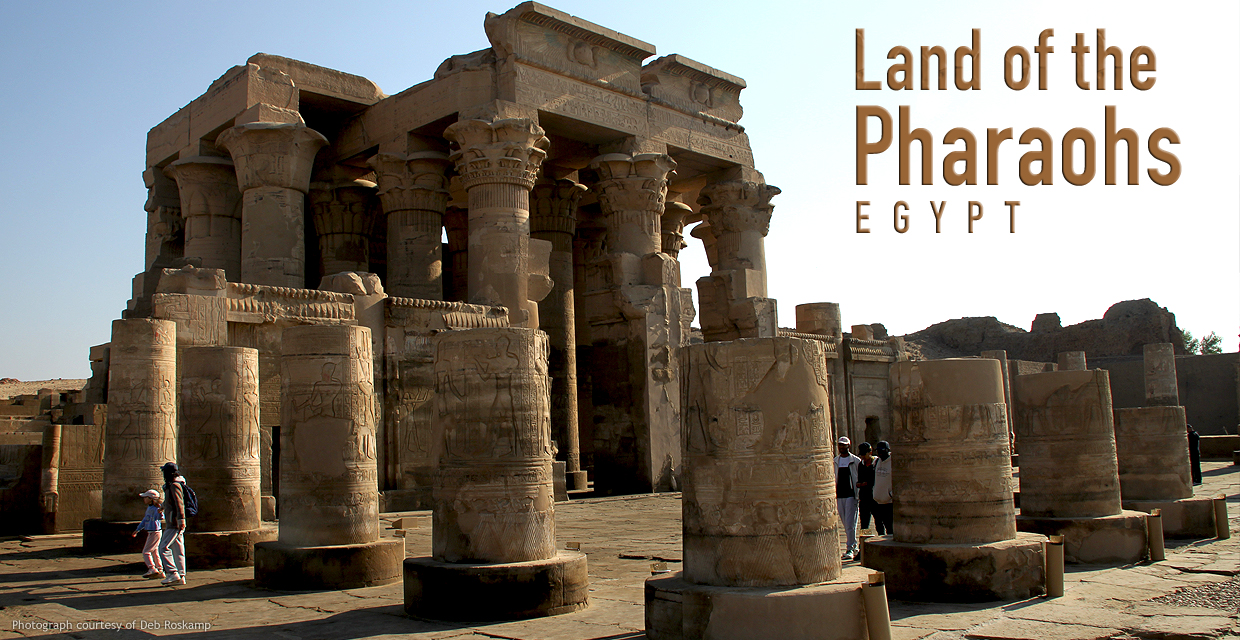
While driving deep into the desert of Egypt’s Sinai Peninsula, we sat three hours in a van, which was part of a convoy, apparently to assist other vans in case of mechanical failures or possible attacks from terrorists or unknown assailants. There were many checkpoints along the way, guarded by soldiers and policemen. With us were two very nervous U.S. tourists who spoke ceaselessly of the nearby war that was geographically close, but emotionally felt light years away. The other occupants in the van consisted of a well-versed driver, an official policeman and our highly educated guide, named Salaam, who seemed indifferent to the two very nervous U.S. tourists’ ridiculous rants. After noticing a lone man in the distance, Salaam began a narrative of the harsh desert landscape of endless sand, and the fractured boulders and craggy mountains, which the nomadic Bedouin People call home.
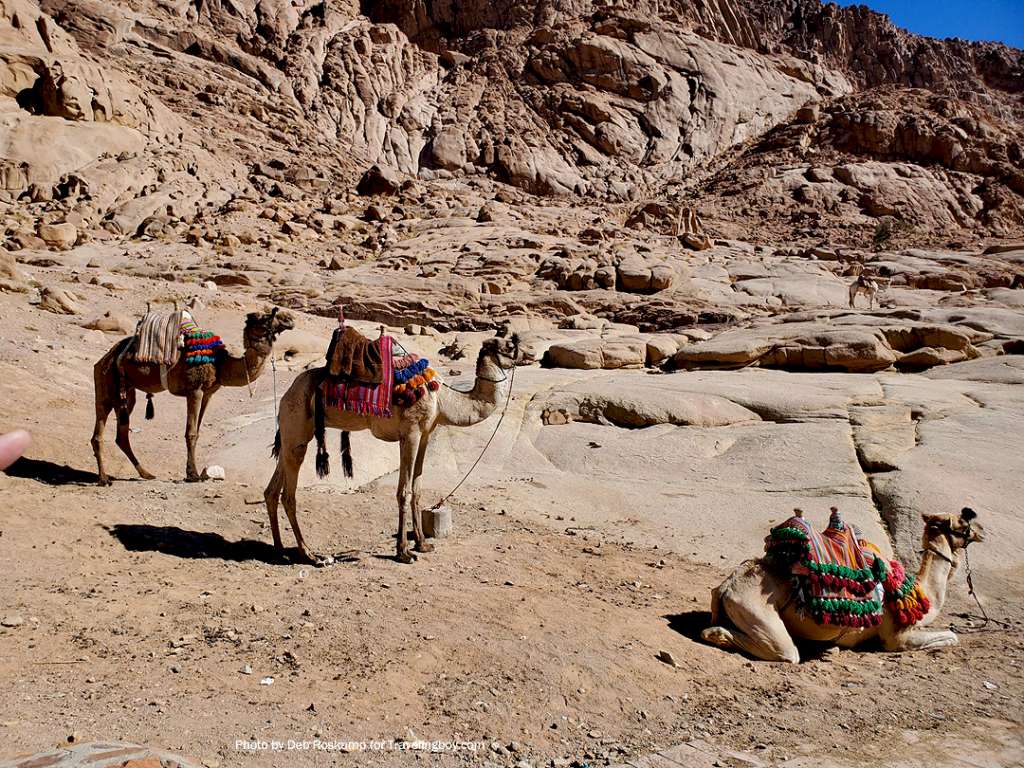
Salaam told us a story, a story which he claimed to a be true: A young Muslim Arab man arrived at the edge of the Sinai Peninsula, and began a trek into the desert. Partway through his journey he took a reprieve upon reaching an older Arabic man. They decided to walk together. The older Arab man asked who the young man was. He replied, ‘Father, don’t you recognize me… I am your son.’ And he really was his son, the 16th son from one of the man’s four Muslim wives, which Salaam reminded us again that the story was true.
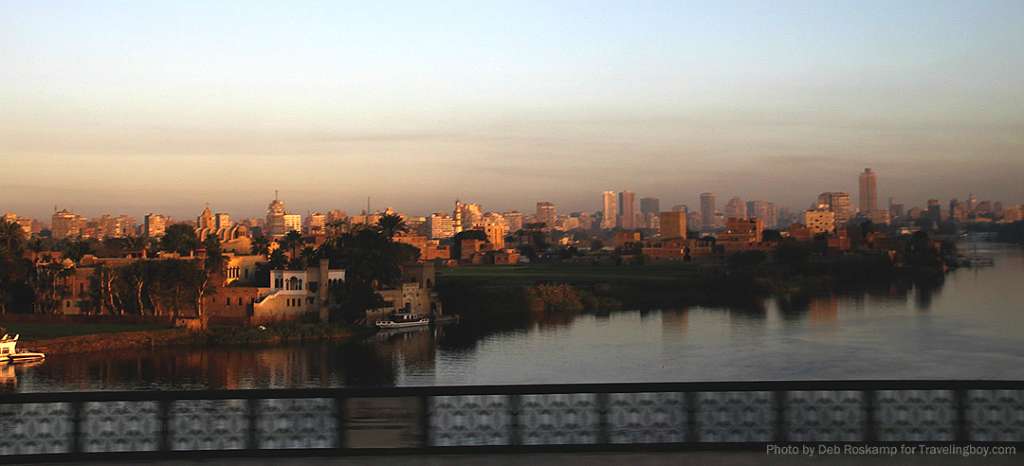
But, I’m getting a ahead of myself, for I had spent ten days earlier on the North African side of Egypt, cruising the River Nile on a river boat and touring Cairo’s many museums: the Museum of Egyptian Antiquities, also known as the Cairo Museum, which holds the world’s largest collection of pharaonic antiquities, the recently renovated National Museum of Egyptian Civilization that showcases over 50,000 artifacts from all areas of Egyptian civilization, from prehistoric times, through the pharaonic era up until today. And the new Grand Egyptian Museum, overlooking the Three Pyramids and Sphinx of Giza. Also in the mix was the Mosque of Muhammad Ali and Citadel, and the City of the Dead.
When speaking with other tourists, I noticed their excitement when they spoke about the main reason why they had traveled such a distance to Cairo. It was generally for these two things…
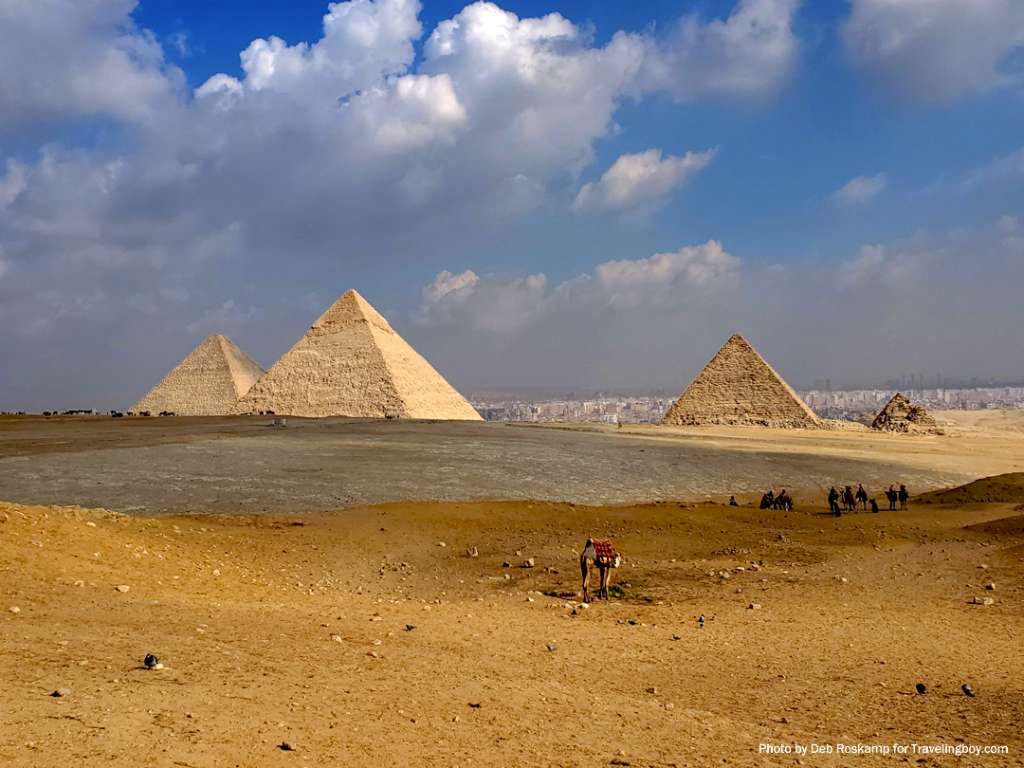
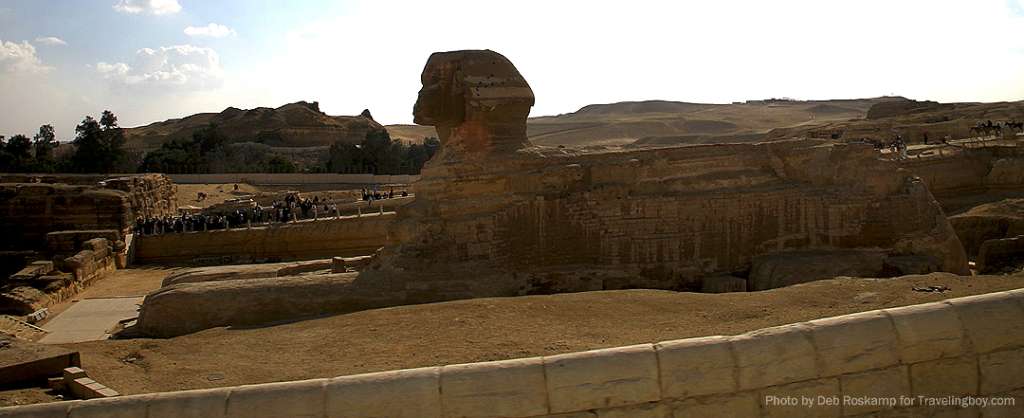
THE CAIRO OF NOW
Now, back on the first leg of my tour, I was anxious to experience the grandeur, the blemishes and the contradictions of the Cairo of today. With a population of over 22.1 million people, Greater Cairo is the 12th largest city in the world. The high birth rate in Egypt, especially among low-income families, is attributed to Cairo’s growing population. Egypt’s capital city is a major economic hub and attracts people from all over the country, people who are looking for job opportunities and a higher standard of living. The city’s economy is based primarily on governmental institutions and services, along with a modern productive sector, which includes developments in textiles and food processing, in particular, with the production of sugar cane. Sadly, hyper-urbanization has resulted in homes, roads, electricity, telephone services and sewers at an unacceptable Western World level.
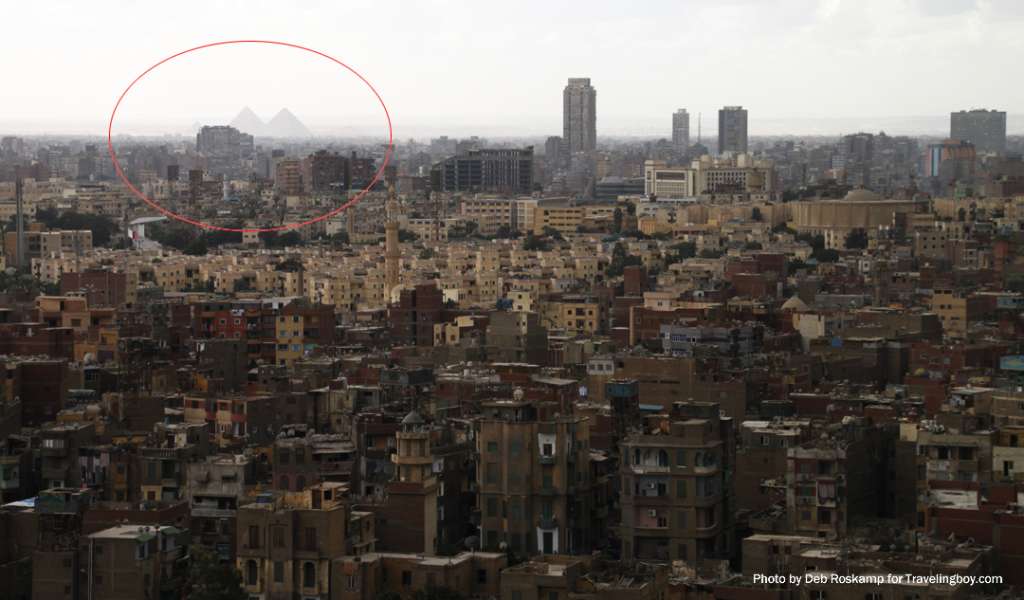
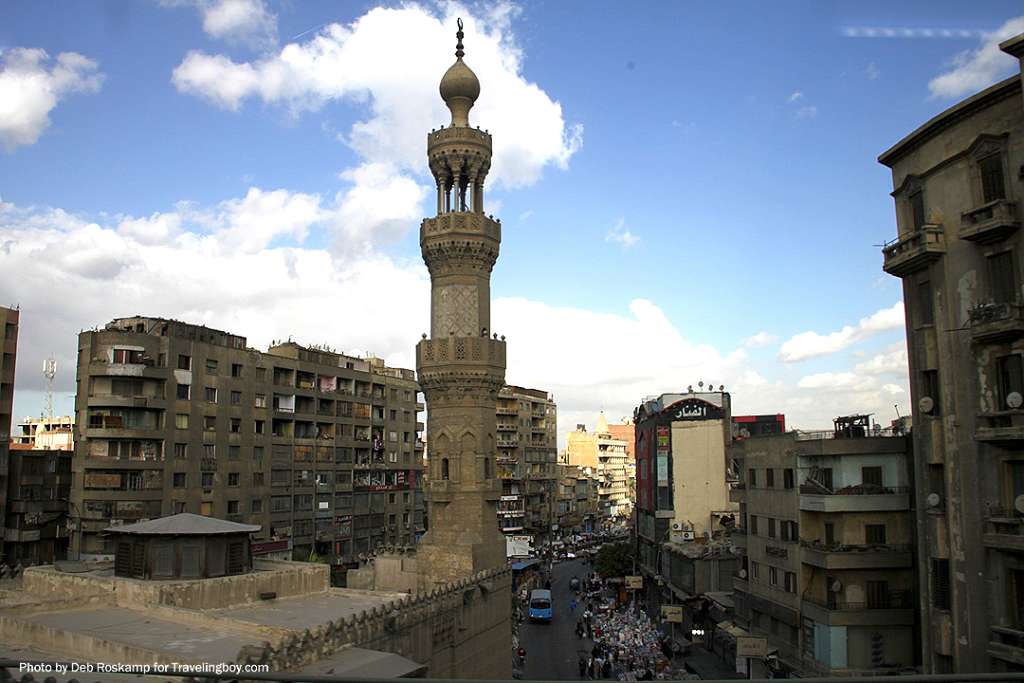
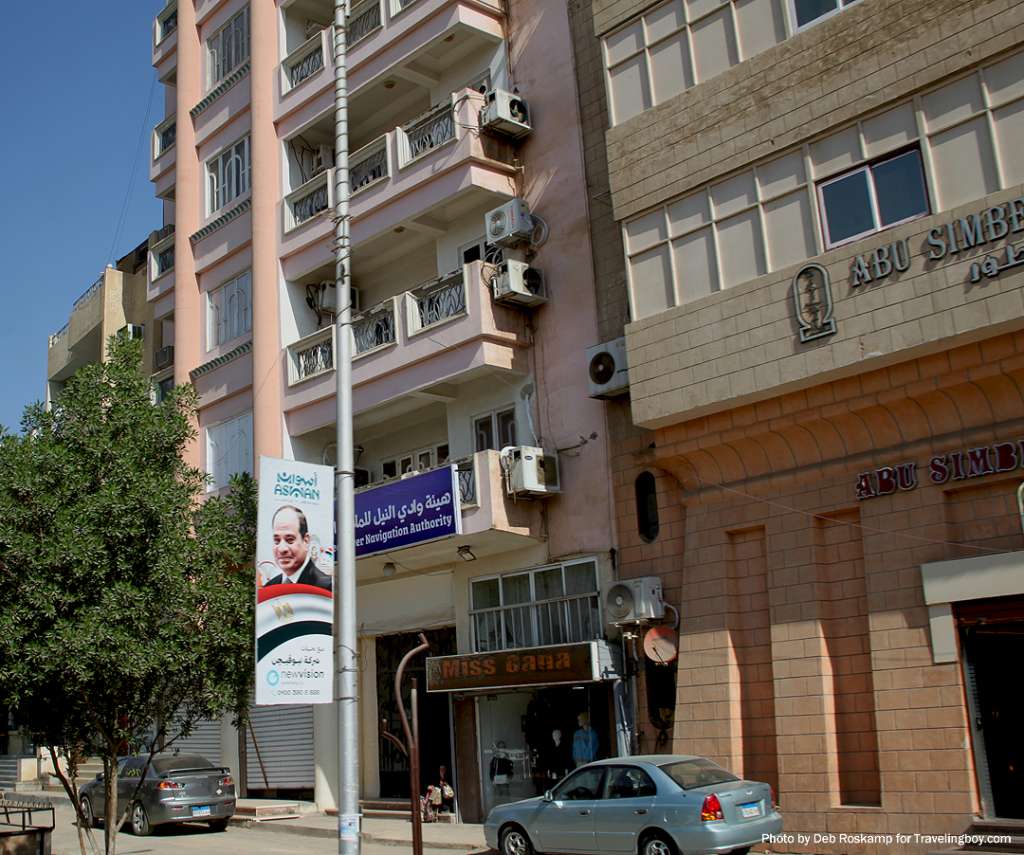
As our van drove to the Mosque of Muhammad Ali, we passed Tahrir Square, the site of Egypt’s Arab Spring, also known as the Egyptian Revolution, where a series of anti-government protests, uprisings and armed rebellions had spread across much of the Arab world in the early 2010s. Millions of Egyptians had taken to the streets against then president Hosni Mubarak, who was ousted, arrested and his government was overthrown. The revolution was led by Abdel-Fattah el-Sissi, a former field marshal, which cemented the Egyptian military’s political dominance, with the controversial, hardliner, el-Sissi himself, as president and dictator for life. The Draconian harshness of el-Sissi’s reign is often ignored by the U.S. government; for after all, we are Egypt’s leading trading partner, and commerce is always more important than human rights in any dictatorial realm.
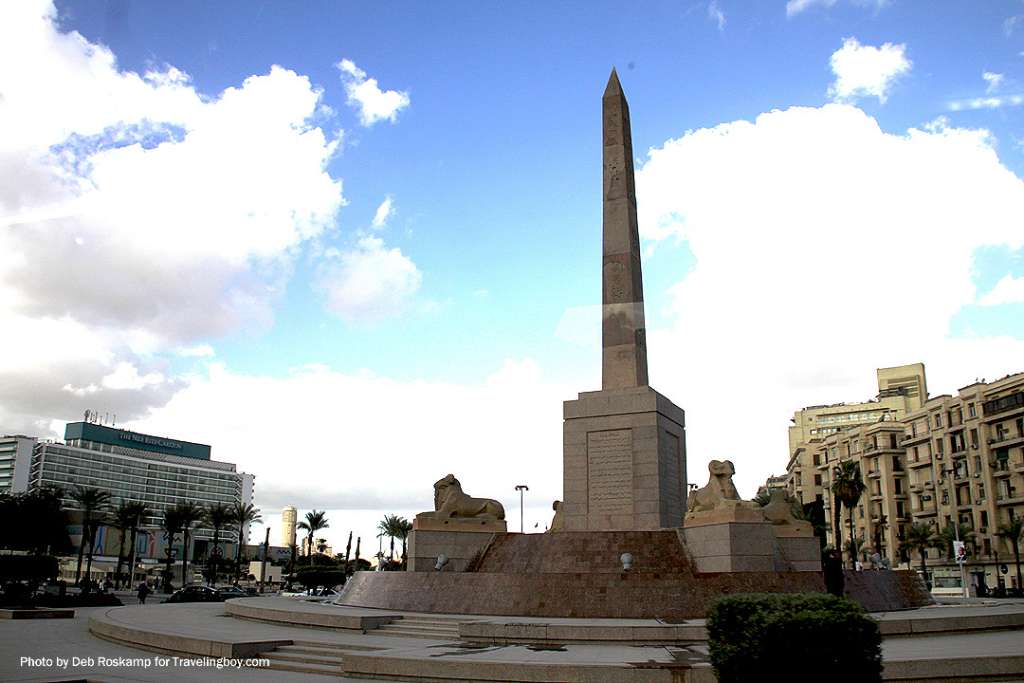
Today, Tahrir Square remains a symbol of the 2011 Egyptian Revolution, with annual democratic celebrations and visits from foreign dignitaries. Yet, as we passed the site, it seemed gentrified and depoliticized, with a smattering of a few Egyptian locals, sitting on benches, drinking coffee and smoking cigarettes. As our tour bus rounded the corner, a British member of our group gave me a nudge, They looked bored and apathetic, didn’t they… with expressions that said, “Was it really all that necesarry to make such a big fuss?”
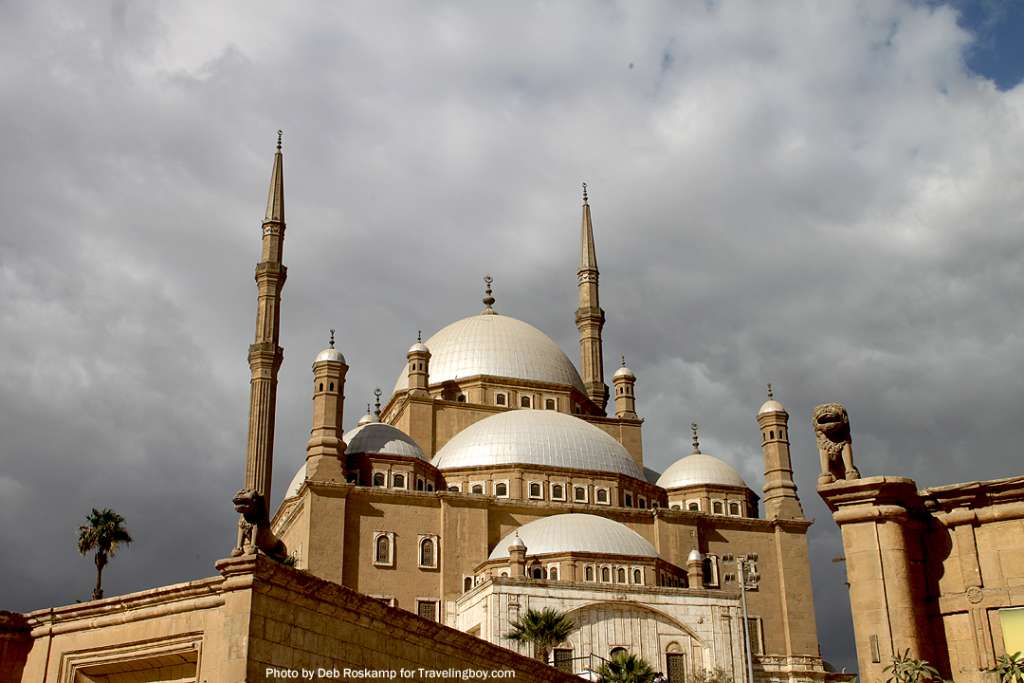
The Mosque of Muhammad Ali
The Muhammad Ali Mosque is situated on the summit of the Citadel (fort) of Cairo. Considered the father of modern Egypt, Muhammad Ali (Muḥammad ibn al-Qāsim al-Thaqafī) built the Muhammad Ali Mosque between 1830 and 1848 in memory of his eldest son. It holds ranks as the most visible mosque in Cairo, and is considered one of the city’s most important tourist attractions. Muhammad Ali was a military commander in an Albanian Ottoman War who defeated the army of Napoleon I during the French occupation. Ali then rose to power through a series of political maneuvers, and in 1805 was named governor of Egypt, where he and his descendants were granted hereditary rule over Egypt and Sudan. Their rule ended with the revolution of 1952 when King Farouk was overthrown by the Free Officers Movement led by Mohamed Naguib and Gamal Adbel Nasser, establishing the Republic of Egypt.
As our group entered the mosque, we took off our shoes in observance of the Islamic purification ritual of Wundu. Yet, how really pure was it when Wundu requires washing your face, hands, arms and feet. But, I took it as a tribute to Moses, who is mentioned more than any other prophet in the Muslim Quran, who some believe wandered the Sinai Desert for forty years without sandals, for it was God’s command to not have any substance between his feet and his holy land. I would learn much more about the prophet Moses later at Saint Catherine’s Monastery, which houses the remnants of the purported Burning Bush, on the Sinai Peninsula.
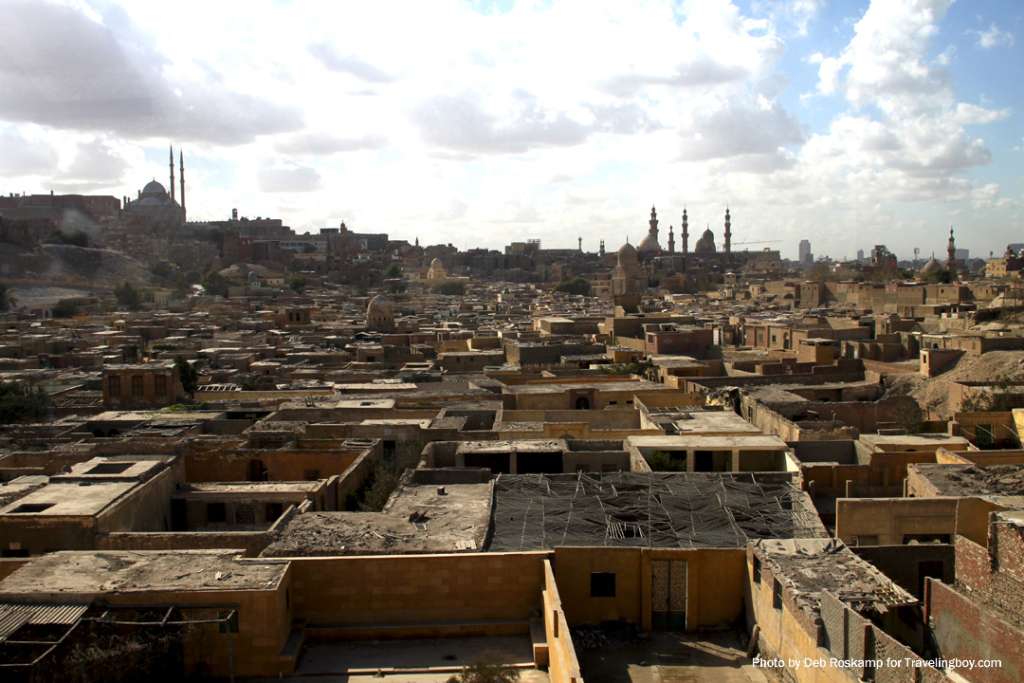
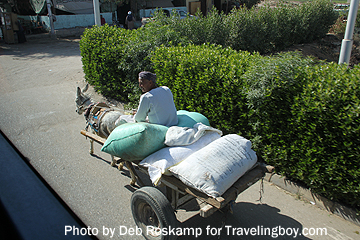
The Citadel and Mosque of Muhammad Ali overlooks The City of the Dead, a series of Islamic necropolises and cemeteries spread over four miles, considered one the largest of its kind in the world. Throughout its history, the necropolis has been home to various inhabitants, including religious scholars, gravediggers, and common urban settlers; as a city-within-a-city where people lived alongside the dead. The necropolises and cemeteries felt a little unsightly, almost ram shackled, due to the improvised housing within the mausoleums, as Cairo contiunes to face urbanization and housing shortages.
Since 2020, the Egyptian government has demolished some historic tombs in the cemetery for the purpose of building new highways and infrastructure, eliciting protests and objections from locals and conservationists. Egypt is known for its antiquities of the past, but also keeps its eyes on the future, as it continues to forge ahead into the modern world.
Fast Forward to Luxor: once the capital of Upper Egypt
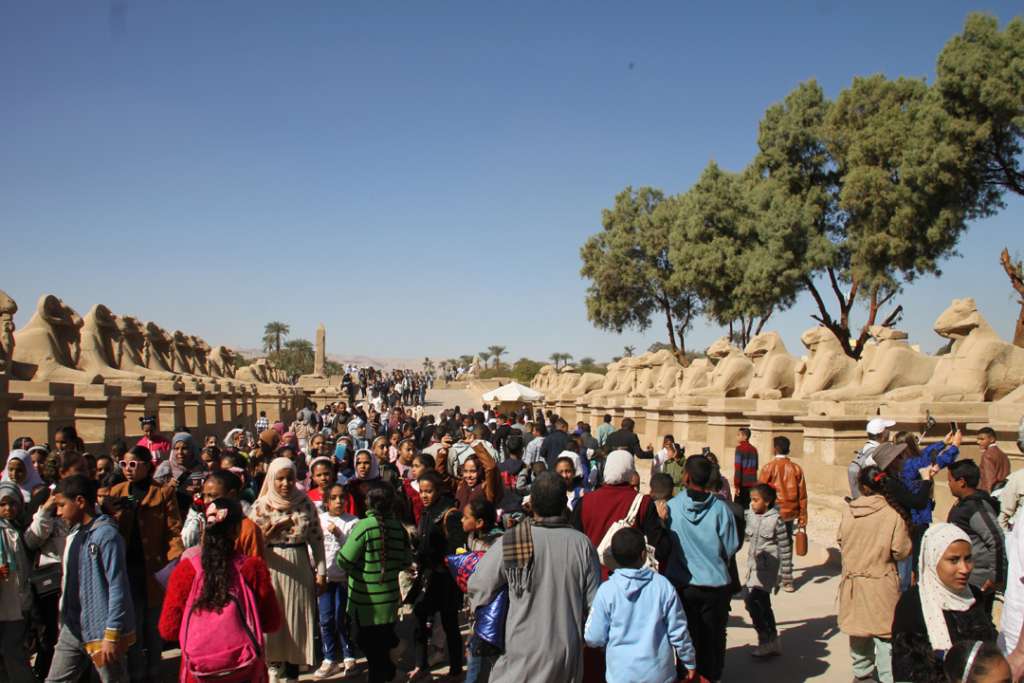
The Egyptian school children on field trips were inquisitive and far more polite than what we have in the U.S. They seemed proud and enamored that tourists would choose to visit their country. Instead of asking for money for a photo taken of them, they would excitedly ask permission to take a photo of us, which would be displayed later in their classrooms. I remembered my previous trip to a Muslim nation, where the snake charmers in Morocco’s Marrakesh Bazaar would demand money when there was even a hint of snapping a photograph of them. The youth literacy rate in Egypt today (people aged 15-24) is at the growing number of 92.24 percent. In the U.S., one in four children grow up without learning how to read and write, primarily due to poverty, homelessness and the inaccessibility of many schools for the poor.
As we continued our march, our trustworthy guide, Wael, informed me that, The Valley of the Kings in Luxor is an area where, for a period of nearly 500 years from the Eighteenth Dynasty to the Twentieth Dynasty, rock-cut tombs were excavated for pharaohs and powerful nobles under the New Kingdom of ancient Egypt. I masked my ignorance and pretense of being the all knowing journalist, and replied, You know, Wael… I think you might be right.
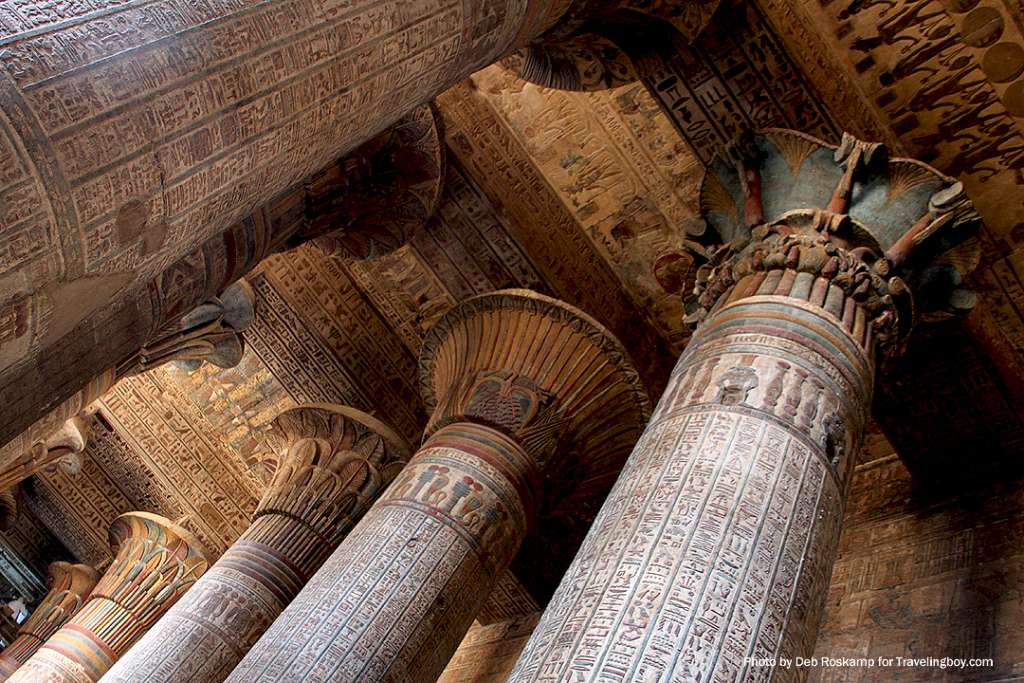
It was the ram-headed creator god, Ptolemy VI Philometor, the Macedonian King of Egypt (180-45 B.C.E), who gave birth to the world’s first creation of a humankind realization, which was completed on his potter’s wheel at the Temple of Khnum.
Witnessing the symbols at the Temple of Khnum was akin to taking a one-way ticket into the ancient past; apparently in a period when written script had not yet been invented — but, it occurred to me that today, written text does exist, yet many of us prefer to use emoji memes to get our messages across. One picture is worth ten thousand words is often regarded as an ancient Chinese proverb, attributed to Confucius, but it’s really taken from an article in a trade journal by the often overlooked, English illustrator, Fred R. Barnard. While trying to understand the history of Egypt, I think of Barnard, and realize it can be difficult to determine what is the truth or what is the false.
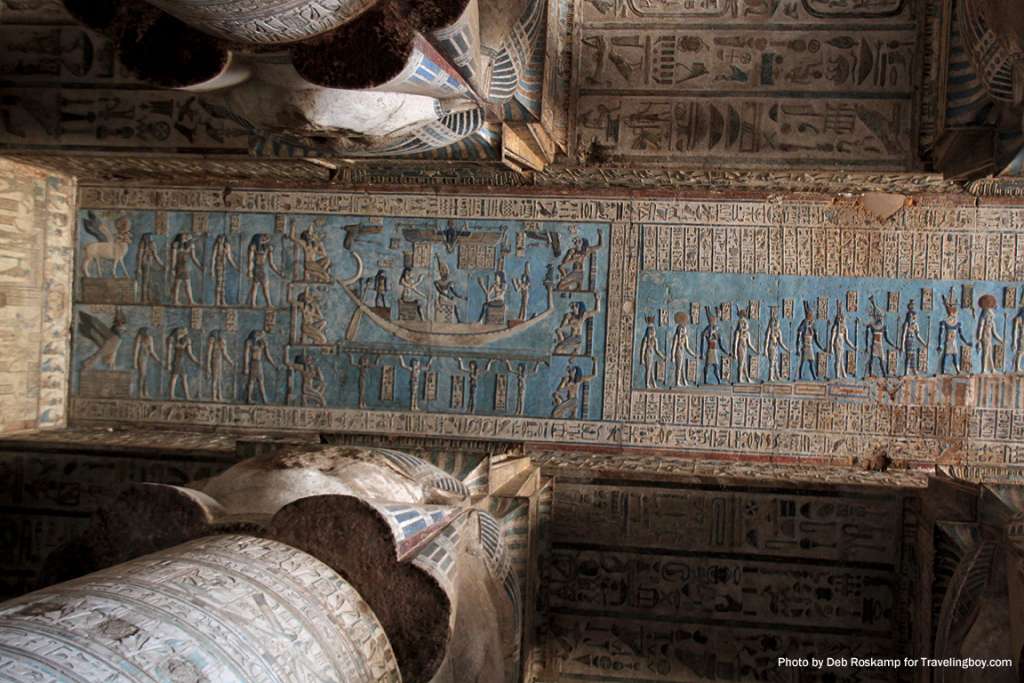
Upon leaving many historical sites, our group would walk through the Valley of Vultures, a derogatory name given by tourist to flocks of street merchants, who would grab hold of your arms, desperately trying to sell you a trinket or shirt. I was not annoyed by their presence. In fact, it was fun, colorful and part of the experience. My only annoyance was directed at a few members of our tour group who found it necessary to laugh when I paid one dollar too much for a couple of shirts. I also noticed they felt lofty enough to laugh at the vendors, vendors who called Egypt home, who might be selling their wares to feed their children and families, who may also live in squalid homes. I realized that I would never be able to explain to them, particularly the one wearing an orange baseball hat, that I really wanted to pay that extra dollar too much. Plus, the 100% Egyptian cotton shirts, proved to be a far better substitute for the Sunday best clothing I had packed in my lost suitcase. And all that unnecessary ruckus for just one lousy U.S. buck. (Spoiler alert: my suitcase was found and returned about a week letter).
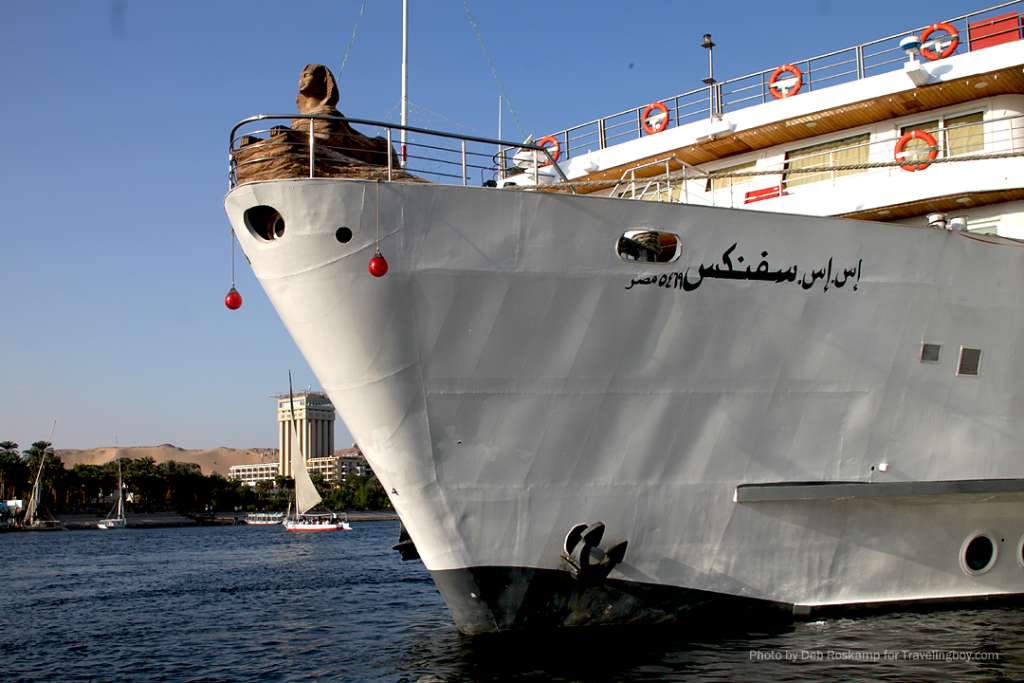
UNIWORLD’S 10-day Nile Riverboat Cruise aboard the SS Sphynx followed the above attractions, as well as the Sinai Peninsula’s Sharm El Sheikh, Bedouin camels and people, and St. Catherine’s Monastery, but I’ll share my experiences in the next two installments.
Wael: UNIWORLD Tour Guide, Extraordinaire
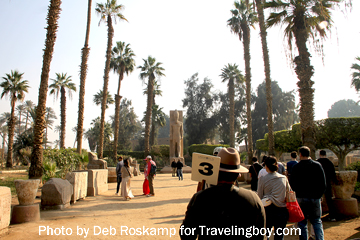
Our tour guide, Wael, held our hands throughout the North African part of our tours. This included the pre-embarkation on the SS Sphynx with museum tours, the riverboat journey on the River Nile and its many land excursions, and the debarkation of the Sphynx, with more museum tours and a day at Giza. Wael was both thoughtful and patience, explaining important information to our group, information which we should have already known.
When my missing suitcase did not appear three-days later on the SS Sphynx, Wael did something that I will never forget – after conducting an all consuming six a.m. dawn to dusk land tour, rather than relaxing and taking a well-earned break, he accessed a car where we drove to an Egyptian clothing store at night. It was not the store of a mysterious cousin; it was a well-known and particularly high-end one, where all garments were made in Egypt with 100% Egyptian cotton from the Nile River Delta.
A few mornings later, I woke up feeling a bit ill, no doubt due to the over-consumption of tasteful barbecued pigeon, a first for me. Wael called and expressed his concern, and was also sad that I would miss that day’s tour. He even suggested that perhaps we could do the tour in the future, with just the two of us. In the evening, and in the next morning, he called me again, for no other reason than to see if I was feeling better.
And this is why I refer to him as, Wael: Tour Guide, Extraordinaire.
POSTSCRIPT
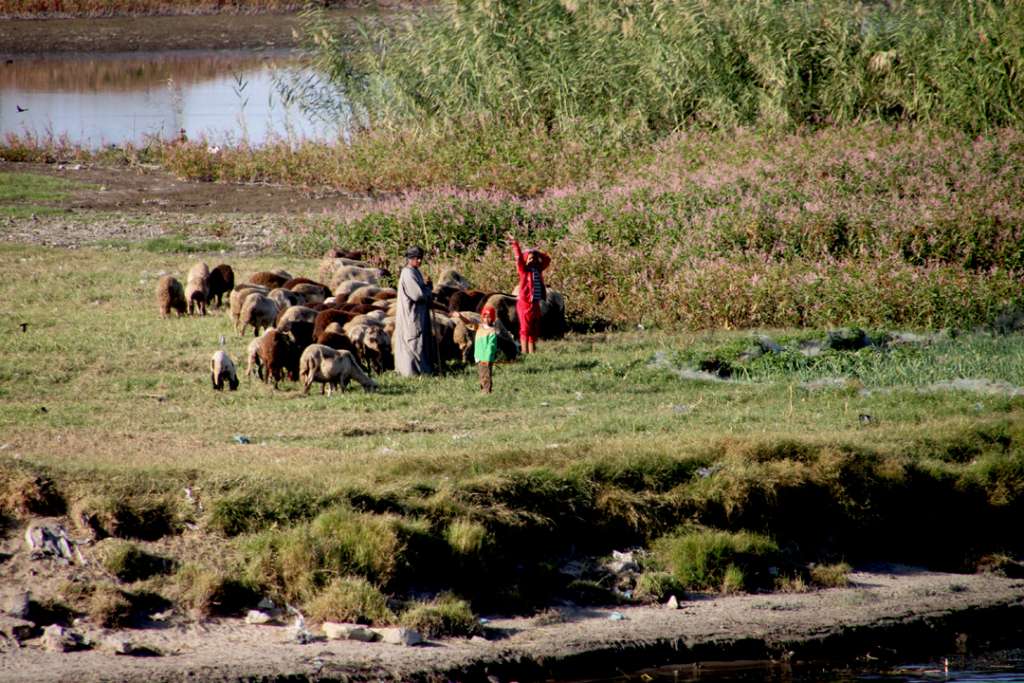
But, before I tackle Installment, Part II, I couldn’t resist including the above photo taken while I was on the Nile riverboat journey. I was surprised that I didn’t see locals swimming and treacherous crocodiles snapping at their heels. An employee on the upper deck held back a smile, Come on, Ed… look at a map. It’s winter down here and nobody swims. And crocodiles can’t make it here because of Nasser Dam.
Later, I really did look at a map, and realized that crocodiles only exist south of the equator, and alligators at its north. Yes, still very much to learn.
Read more about our Egypt adventure:
- A personal interpretation of its land, people and antiquities, Part II.
- Egypt, Part III: Saint Catherine’s Monastery
For more on Egypt, visit Fyllis Hockman’s Egypt: 6000 Years of History Come Alive Throughout the Country – Traveling Boy.























Walter
March 19, 2024 at 3:18 pm
I must say, your coverage of Egypt is extremely personal and engaging (Wael will be sought after by future travelers you should get a commission). And Deb’s photographs were amazing as ever. I particularly appreciated her unusual angles — like the Sphynx — I had never seen it from the side before … didn’t realize it was that long … and the density of the cityscape. Your combination of prose and photography is definitely a view of the roads less traveled.
Ed
March 29, 2024 at 12:01 pm
Walter – Thank you for your kind words of praise. I will pass along your comments to our photographer, Deb Roskamp. Please stay tuned for our next four installments on Egypt, where you’ll find futher spectacular photos from Deb Roskamp. – Ed
Bonnie
March 19, 2024 at 3:19 pm
Amazing article
Ed
March 29, 2024 at 12:04 pm
Thank you, Bonnie. A single word, such as yours, is enough to make our day. – Ed
Jerry
April 3, 2024 at 7:58 am
Fabulous article Mr. Boitano. I really got into your curiosity of the land. Loved those photos Miss Roskamp. This article is just as good as any National Geographic piece. I learned so much about the land and its people.
Surprised that they don’t have a lot of cars. Don’t they have oil in Egypt?
Helen
April 3, 2024 at 7:59 am
Your take on those other tourists remind me of a lot of snobby people I know. Good for you that you paid more to support their families.
Richard
April 3, 2024 at 8:01 am
When I do go visit Egypt, I will definitely look for Wael. Thanks for the tip.
Lee
April 3, 2024 at 8:05 am
The story about Moses traveling for 40 years without sandals is not completely accurate. Moses and the Hebrews did travel 40 years in the desert but they wore sandals. The miraculous part is that those sandals lasted them 40 years.
Read your Bible in Deuteronomy 29:5 — “I have led you forty years in the wilderness. Your clothes have not worn out on you, and your sandals have not worn off your feet.”
Joseph
April 3, 2024 at 8:08 am
That picture of the city with the Pyramids way in the distance is the first time I saw it from that perspective. It changed my concept of the city completely.
Wonderful article, man.
Norbert
April 3, 2024 at 8:11 am
I love that quote about the father who didn’t even recognize his own son. With so many wives, it makes sense.
I think in their macho culture, the women would be only too willing to be taken cared of by somebody … even a total drip … than to face life on their own.
Do you agree?
Sarah
April 3, 2024 at 8:12 am
I didn’t know about the political history of Egypt. Thanks for the short lesson.
Veronica
April 3, 2024 at 8:13 am
Is this Muhammed Ali where Cassius Clay got his name from?
Tom
April 3, 2024 at 8:14 am
Can’t wait for the next edition. Loved your article!
Hilda
April 3, 2024 at 8:16 am
Did the City of the Dead stink? What did Cairo smell like? Was it noisy? Did they have electricity? Water supply? How was the bathroom? Was it cheap? Could you wander around on your own? Was it safe?
Jessica
April 3, 2024 at 8:18 am
You took a chance going there knowing full well that war at the Gaza strip was going on, didn’t you? Were people worried? Did they speak English? What is the life expectancy?